100% Women: Interview with Niamh Coghlan, Sales Director of Richard Saltoun
by Fernanda Lai
“100% Women” — Richard Saltoun’s recent announcement to display nothing but female artists for an entire year is unprecedented in the art world. Furthermore, Saltoun’s seven-year-old gallery, which focuses on conceptual art and performance art, as well as art made by women, has long had a female-heavy roster, making their commitment a bold move as well as a natural progression.
I sat down with Niamh Coghlan, sales director at Richard Saltoun, to discuss her thoughts on “100% Women” last week.
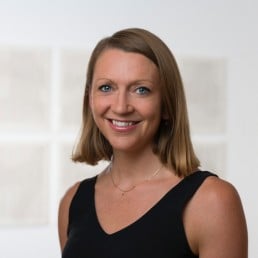
Niamh Coghlan, Sales Director at Richard Saltoun. Photo courtesy of Niamh Coghlan.
Hi Niamh, could you tell us more about the impetus behind “100% Women”?
“100% Women” came about very organically. We were looking at our programme for the year ahead and talking about how many museums and foundations were coming up with initiatives to support women and having women-focused exhibitions. We then realised that 90% of our programming was already on female artists, and we just thought — why don’t we make it 100%? We also took a look at our fair programming, which tends to be a bit more dynamic to see if we could include more women there as well. We decided to begin on March 1st to coincide with our solo exhibition of Rose English, and from thereon, every exhibition, art fair, and digital exhibition at the gallery is going to be focused on women.
Is there a reason why focusing on women feels important now?
Obviously #metoo has done a lot internationally to reinvigorate discussions around gender equality, but more specifically within the fine arts, I think it’s just one of those moments in the UK. With Marina Balshaw becoming the director of the Tate in 2017, there’s been a lot of interest and discussion around women and their professional role in the arts. She’s been very vocal about what she’s gone through and endured, and it struck a chord with a lot of women. In the UK, we have a lot of women in power in institutions. There should be more obviously, but I think we’re actually quite progressive compared to a lot of other countries in that aspect. However, looking at the representation of artists in commercial galleries, that’s not the case. Some galleries have 100% men in their programming and don’t represent even one female artist. That’s quite shocking to me because you’re ignoring an entire gender and their output.
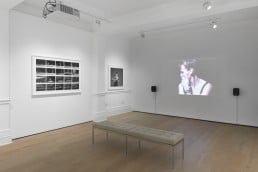
Rose English ‘Form, Feminisms, Femininities’ Installation view, 2019
Photography by Ben Westoby © The Artist; Courtesy Richard Saltoun Gallery.
Do you find it surprising that you’re the first gallery in the UK to announce “100% Women” for a year?
Despite the fact that we are Richard Saltoun, a male-owned gallery, we are primarily staffed by females. At a core level, two out of three directors are female, the other being Allison Thorpe, and I think we are fairly progressive in how our company is structured. We had a lot of support when we first started that discussion, since increasing diversity and improving equality is something we are passionate about as a gallery, and you wouldn’t work here if you weren’t passionate about it.
Do you have any concerns about “100% Women”?
You do worry if this is a risk. You do wonder if it will be perceived as jumping on a bandwagon, which we are not, because a core part of our programming, as you’ve pointed out, has always been female artists, and more explicitly, pioneering and avant-garde female artists who work with a socio-political intent, so this move towards “100% Women” is a natural progression for us.
Richard commented in an interview that his intent behind “100% Women” was to make it so that “female artist” would no longer require an emphasis on female. With that in mind, how did you decide on the title for this initiative?
Vocabulary is so contentious and rife with different meanings. Ultimately, we want to be sitting here and having a conversation about who are the great artists, regardless of gender, race, class. Unfortunately, we are not in that position yet, so we need to give support to female artists, artists of the LGBTQ community and ethnic minorities. Until we are at the stage where everybody has equal opportunity, without regard to race or gender, it does have to be an issue.
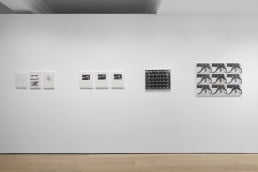
Rose English ‘Form, Feminisms, Femininities’ Installation view, 2019
Photography by Ben Westoby © The Artist; Courtesy Richard Saltoun Gallery.
Richard Saltoun’s programming around ten years ago was much more focused on artists from the 60s and 70s. Do you think the appetite for female artists has changed these days?
I wouldn’t say that the appetite has changed so much as evolved. Maybe 10 years ago, it was about bringing attention to the key and influential artists of the 60s and 70s, like Hannah Wilke and Marina Abramović. They’re now much more recognised and household names, which is great, and I think that obviously connects to our next step of looking into artists who are less well-known from that period or from a slightly younger generation. There is now more interest in artists working in the 80s and the 90s and reanalysing their work, whether that is someone like Tracey Emin, or someone even more contemporary. It’s important that we look across the board from the 60s onwards. As one of our artists recently pointed out to us, “Every five years there is a conversation about gender and equality. And we have to make sure this time it’s not just another conversation and that we actually do something about it.”
The artist who said that was actually Rose English. One of the reasons we wanted to kickoff with her was because she’s someone who’s struggled to be seen in a certain light in the commercial art market, but she has endured and it’s a rightful stay.
Speaking of which, could you tell us a bit more about your choice to start with Rose English?
There are plenty of reasons, but I think one of them is that she is a working woman artist whose practice has continued to develop since the 70s. Her work has always had a strong feminist stance, especially with the way she blurred the lines between performance art and her use of the body. Rose is a perfect example of an artist who has been active for decades, and made significant contributions to her respective field, yet hasn’t necessarily had the recognition she deserves. Remarkably, this is her first solo exhibition in a commercial gallery.
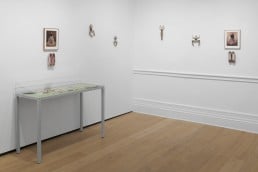
Rose English ‘Form, Feminisms, Femininities’ Installation view, 2019
Photography by Ben Westoby © The Artist; Courtesy Richard Saltoun Gallery.
Do you have a favourite piece from the exhibition?
I love two ceramic pieces in particular, a moulded porcelain breast and a dancing ballerina. Rose studied and worked a lot with ceramics when she first began her career as an artist, primarily to use as props in her performances. They’re just such beautiful objects, and she hasn’t really shown these before. Alongside that is a work titled Plato’s Chair, to which we’ve dedicated an entire room of the exhibition. The installation features a video of this performance from when Rose first performed it in Toronto in 1983. It’s an interesting work because it shows how Rose was looking at performance art. The performance toured to a number of cities — including London, Vancouver and Montreal — but each presentation was completely different. It’s such an important piece in the history of performance art and the theatrical stage.
Is there a guiding thought to the programming, apart from featuring female artists?
At the core of it, I see it as giving support to female artists. That’s what it is really: to exhibit and promote the work of women artists, whether their work is staunchly political, or whether it’s not, whether it’s someone like Lili Dujourie or Gina Pane. It’s about giving a context and venue to show these works and create a buzz around it. We want to make sure these women receive their rightful place.
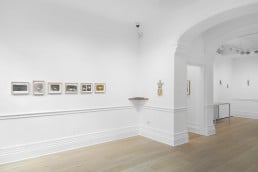
Rose English ‘Form, Feminisms, Femininities’ Installation view, 2019
Photography by Ben Westoby © The Artist; Courtesy Richard Saltoun Gallery.
Is there something you are hoping will happen because of your programming?
On a basic level, I hope that galleries will look at their own programming, investigate the history of it and do research. I hope that they will look outside the box at artists who haven’t been written into history, but out of it. There are so many phenomenal artists who have created incredible works, but because they’re female or a minority, they’ve never had their works looked at in a commercial or critical way. In addition to more commercial galleries and institutions nurturing a gender balance within their programmes, we hope to inspire more collectors to see the gaping hole in their collections and using their collecting as a form of activism to address such persistent inequality.
I’ve heard that Richard Saltoun is also going to expand into LGBTQ artists, race and ethnic minority artists. Given that Richard Saltoun also focuses on artists who are “underrepresented” in the broad sense of the term, how did the decision to start moving in a more specific direction come about?
To be honest, it actually came about through the “100% Women” programme. When we started analysing our own statistics — how many women artists do we have and represent? — we discovered that it had an even split, which is interesting. We then started scrutinising demographics and it became readily apparent that most of them are white and middle-class. We realised we were also not looking outside of the box as much as we were encouraging other people to do so in terms of gender. It was a rude awakening to understand the inconsistencies in our own programming, so we will be doing more research around it and exploring it further, particularly through our new series of digital exhibitions.
With gender fluidity gradually replacing binary ways of looking at gender and art, how does that feature in your programming and change what constitutes “underrepresented,” in the broad sense of the term?
It’s always something we’ve been preoccupied with in our programme since we did the exhibition “Transformer: Aspects of Travesty” in 2014, which was a re-proposition of the original exhibition curated by Jean-Christophe Ammann 1974. We are revisiting this concept at Miart this year, which we’re titling ‘Transformers’. The focus will be on artists who challenge socially constructed notions of gender and celebrate gender’s fluidity in their work. It’s something we’re interested in and want to make more of.
“100% Women” begins on March 1st with a solo show of interdisciplinary British artist Rose English, which will cover her photography, painting and ceramic work, recognising her contributions and importance to British art. This will be followed by another seven shows, including Renate Bertlmann, Gina Pane and Lili Dujourie, and supplemented by a series of talks, films, and lectures, as well as a new series of online exhibitions hosted on the gallery’s recently relaunched website.